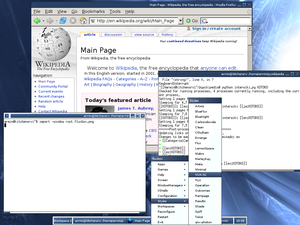Fluxbox
| Fluxbox
|
|
|---|---|

|
|
 Screenshot of Fluxbox |
|
| Basic data
|
|
| developer | Henrik Kinnunen |
| Publishing year | 2001 |
| Current version | 1.3.7 (February 8, 2015) |
| operating system | Unixoids |
| programming language | C ++ |
| category | Window manager |
| License | MIT license |
| German speaking | Yes |
| fluxbox.org | |
Fluxbox is a window manager for the X Window System in Unix-like operating systems . The developers focus on using resources as sparingly as possible and on in-depth configuration options.
overview
Fluxbox emerged as a spin-off from Blackbox and is largely identical to it in terms of configuration and handling. The developers focus both on a clearly designed interface and on a way of working that is as resource-efficient as possible. Fluxbox is characterized by a low utilization of the main memory and main processor , as well as less storage space on the hard disk. This is achieved by deliberately avoiding elaborately designed graphics, animations or other properties that would increase system utilization. The use of Fluxbox can therefore be particularly advantageous for use on low-performance systems such as older computers or live systems . The distribution Damn Small Linux uses Fluxbox by default. Also of Ubuntu there was with Fluxbuntu and Linux Mint Fluxbox specially designed for Fluxbox derivatives.
particularities
Despite its simplicity, Fluxbox can be customized to a large extent. The windows of programs with a graphical user interface can be configured in detail in terms of their behavior, appearance and size and can even be combined into a unit (similar to tabbed browsing ), regardless of whether the respective program supports this or not. Other options for customization, such as setting keyboard shortcuts , editing the menus, or creating new desktop themes, are also available. All settings are made via configuration files that contain plain text and can be edited with standard text editors .